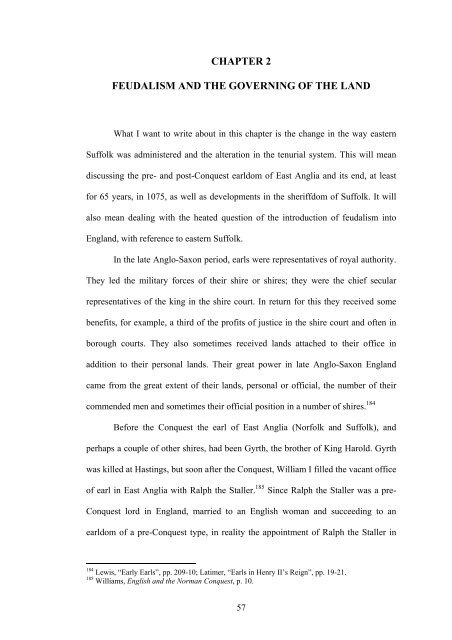I certify that I have read this thesis and have ... - Bilkent University
I certify that I have read this thesis and have ... - Bilkent University
I certify that I have read this thesis and have ... - Bilkent University
You also want an ePaper? Increase the reach of your titles
YUMPU automatically turns print PDFs into web optimized ePapers that Google loves.
CHAPTER 2<br />
FEUDALISM AND THE GOVERNING OF THE LAND<br />
What I want to write about in <strong>this</strong> chapter is the change in the way eastern<br />
Suffolk was administered <strong>and</strong> the alteration in the tenurial system. This will mean<br />
discussing the pre- <strong>and</strong> post-Conquest earldom of East Anglia <strong>and</strong> its end, at least<br />
for 65 years, in 1075, as well as developments in the sheriffdom of Suffolk. It will<br />
also mean dealing with the heated question of the introduction of feudalism into<br />
Engl<strong>and</strong>, with reference to eastern Suffolk.<br />
In the late Anglo-Saxon period, earls were representatives of royal authority.<br />
They led the military forces of their shire or shires; they were the chief secular<br />
representatives of the king in the shire court. In return for <strong>this</strong> they received some<br />
benefits, for example, a third of the profits of justice in the shire court <strong>and</strong> often in<br />
borough courts. They also sometimes received l<strong>and</strong>s attached to their office in<br />
addition to their personal l<strong>and</strong>s. Their great power in late Anglo-Saxon Engl<strong>and</strong><br />
came from the great extent of their l<strong>and</strong>s, personal or official, the number of their<br />
commended men <strong>and</strong> sometimes their official position in a number of shires. 184<br />
Before the Conquest the earl of East Anglia (Norfolk <strong>and</strong> Suffolk), <strong>and</strong><br />
perhaps a couple of other shires, had been Gyrth, the brother of King Harold. Gyrth<br />
was killed at Hastings, but soon after the Conquest, William I filled the vacant office<br />
of earl in East Anglia with Ralph the Staller. 185 Since Ralph the Staller was a pre-<br />
Conquest lord in Engl<strong>and</strong>, married to an English woman <strong>and</strong> succeeding to an<br />
earldom of a pre-Conquest type, in reality the appointment of Ralph the Staller in<br />
184 Lewis, “Early Earls”, pp. 209-10; Latimer, “Earls in Henry II’s Reign”, pp. 19-21.<br />
185 Williams, English <strong>and</strong> the Norman Conquest, p. 10.<br />
57
















